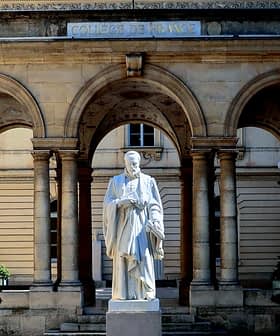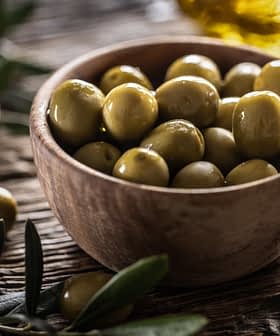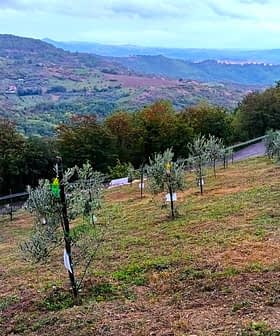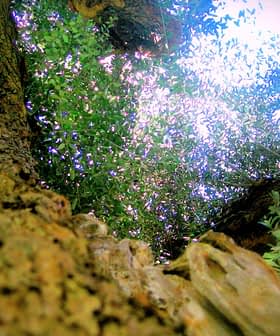Rare Variety Unites Bosnia and Herzegovina in Olive Grove of Hope
Catholics, Orthodox Christians and Muslims involved in Herzegovina’s olive sector planted 33 white Leucocarpa olives at a convent to celebrate unity.
 Marko Ivanković, director of the Federal Agro-Mediterranean Institute
Marko Ivanković, director of the Federal Agro-Mediterranean Institute Olive farming in Herzegovina, Bosnia and Herzegovina, has grown significantly in recent years, with new plantations, including a special one at the Convent of the Franciscan Sisters of Christ the King. The Olive Grove of Hope, established at the convent, symbolizes unity among people of different faiths in the region, promoting national unity and hope for a better future through agriculture and olive growing. The project aims to bring together Christians and Muslims in a way that surpasses the Dayton Accords, emphasizing peace, connection, and collective love.
Olive farming in Herzegovina, the southern region of Bosnia and Herzegovina is developing by leaps and bounds.
About ten years ago, there were only 80 olive trees, and today, 116,000 olive trees are cultivated on 520 hectares.
New plantations continue to be established, including an unusual one at the Convent of the Franciscan Sisters of Christ the King in Bijelo Polje, Potoci, north of Mostar, Herzegovina’s largest city.
It was an event much more important than a simple planting. An opportunity to reflect on peace, connection and love, everything that unites us and makes us equal.
“This is the Olive Grove of Hope,” said nun Dajana Dujmović, director of the company Paxa Dola (translated as Valley of Peace), which manages the monastery’s olive groves.
Along with the 3,500 drip-irrigated Oblica, Istrian bjelica, Pendolino, Cipressino and Ascolana tenerra trees planted 13 years ago on about 14 hectares, the monastery also hosts the rare Leucocarpa variety, colloquially called the “white olive.”

Participants in the planting of “white olives” in the Olive Tree of Hope
“Its fruits look like pearls, and its oil has been used for the ordination of priests since ancient times,” Dujmović said. “The silvery crown and white fruits have become a sign of purity, renewal and the indestructibility of good.”
See Also:Producers in Herzegovina Celebrate New PDOThe idea ofbuilding the Olive Grove of Hope from this variety came spontaneously. During a study trip to Italy, organized by the Herzegovina Association of Olive Growers and Oil Producers (HUUM), a spontaneous conversation arose about the rarity of white olive seedlings, also known as Leucolea.
HUUM, which unites members of three ethnic groups — Croats, Serbs and Bosniaks — and three religions — Catholicism, Orthodoxy and Islam — facilitated the exchange among participants, who noted how difficult it is to obtain these seedlings.
This realization sparked an unexpected reaction – everyone expressed a desire to acquire at least one sapling.
However, this story was even more special because the trip participants were people of three different faiths who joined the project without hesitation, connecting through a common desire to contribute to creating something valuable and lasting.
Religion played a significant role in the bloody Bosnian War, which saw Muslim-majority Bosniaks and Catholic-majority Bosnian Croats fight Orthodox Bosnian Serbs to maintain the independence of Bosnia and Herzegovina from Yugoslavia from 1992 to 1995.
The conflict included the Srebrenica genocide, where Bosnian Serb forces systematically murdered 8,000 Bosniak men and boys and forced 20,000 others to leave their homes.
The memory of the event has been seared into the national consciousness, and tension between the various ethnic and religious groups has never fully abated.
To promote national unity, the HUUM group acquired 33 Leucolea saplings, corresponding to the age of Jesus Christ at the crucifixion. The search for the first 15 trees ended successfully on the trip to Italy. But the story did not stop there.
The well-known agronomist and olive grower Božo Mustapić from Neum took on the challenge of finding donors for the remaining 18 trees.
“No matter how many more trees need to be purchased, I will find people who want it,” Mustapić said.
Indeed, more people got involved in the purchase, and many shared the costs so that they could participate.
“But it wasn’t just about money here – the most important thing was togetherness, meeting and connecting through a noble cause,” Dujmović said.
From the beginning, he said it was clear that this project went beyond planting the olive trees. Everyone who decided to participate took on the obligation to finance the purchase of the white olive trees and plant them.
The planting took place on February 21st, and the response exceeded expectations.
In addition to nuns, priests, and olive growers from Herzegovina, diplomats, foreign ambassadors, and politicians participated in the unusual event, including the country’s president and agriculture minister, who planted a tree.

Minister of Agriculture Kemal Hrnjić
“The olive tree is not only an agricultural crop but a symbol of hope and endurance. Planting an olive tree means investing in the future,” said Minister of Agriculture, Water Management and Forestry Kemal Hrnjić. “This olive grove should be a witness to the hope that we can build a better future.”
“I hope this project will inspire others to dedicate themselves to agriculture and olive growing,” President Lidija Bradara added.

Lidija Bradara, President of the Federation of Bosnia and Herzegovina
Miljan Grgić-Porfirije, vice president of HUUM and hieromonk (a title in the Orthodox Church similar to a monk and priest) at the Tvrdoš Monastery near Trebinje, a town about 30 kilometers north of the Croatian city of Dubrovnik, also planted his olive tree.
The monastery is known for its top-quality wines and award-winning extra virgin olive oil. “This year, for the first time, we will also participate in the NYIOOC World Olive Oil Competition,” Grgić-Porfirije said.
He said Tvrdoš is one of the most visited monasteries in the Serbian Orthodox Church, with 350,000 visitors of different religions and nationalities passing through it annually. “It brings people from all over the world together through spirituality and hospitality,” he said.
Ramiz Zajmović, a HUUM board member and director of the organic agriculture firm AgorHerc, also planted a Leucocarpa seedling.
The company cultivated 15,000 olive trees, wild roses, figs and lavender on 140 hectares on a hill above the town of Gabela.
“Everything is organic and holistic, for which we are the only one in Bosnia and Herzegovina to have the Demeter certificate,” said Zajmović, a Muslim.
Under the slogan “Unity in Diversity,” all participants planted 33 Leucocarpa seedlings. Friar Svetozar Kraljević blessed the newly created olive grove and all those gathered.

The Leucocarpa seedling was planted by Porphyry from the Orthodox monastery Tvrdoš
“It was an event much more important than a simple planting,” Dujmović said. “An opportunity to reflect on peace, connection and love, everything that unites us and makes us equal.”
She is convinced that the Olive Grove of Hope will become a place of meeting, prayer, reflection and hope, where everyone can find their “station” and “olive tree of hope.”
“This olive grove of ours is not just an ordinary economic venture but a symbol of God’s presence and love,” Dujmović said.
Numerous visitors also feel this way. The sisters organize an olive harvest day with volunteers and visitors every year.
The olives are then milled into the convent’s dedicated olive oil brand, Paxa Monastery. The label, which is recognizable, depicts a silhouette of a nun and an olive tree.
The label’s white color symbolizes purity and peace, while the gold colors reflect the divine, creating harmony that reflects togetherness and collective connection.
“The sign of Alpha and Omega (the beginning and the end) directs our hearts towards the reality of where we came from and where we are returning,” Dujmović said.
The previous olive harvest was approximately 33,000 metric tons, about 50 percent below initial expectations due to significant hail damage in May.
The average oil yield was also slightly lower than in previous years, amounting to about 10 percent, below the typical 12 to 15 percent range.
Since this is the northernmost olive grove, above which there is typically snow on the Velež hill throughout the winter and early spring, the vegetation and fruit ripening are late compared to the country’s southern regions. This difference was even more pronounced last season.
However, as usual, the nuns carried out the harvest from October 10th to 20th and yielded high-quality olive oil with more than 250 milligrams of polyphenols per liter. This means the oil meets E.U. Regulation 432/2012 on medicinal claims for olive oils.
E.U. Regulation 432/2012
E.U. Regulation 432/2012 permits olive oil producers to claim that polyphenols help protect blood lipids from oxidative stress, provided the oil contains at least five milligrams of hydroxytyrosol and its derivatives per 20 grams.
Given its established olive oil production and rising price charges by the usual miller, the convent plans to purchase an olive mill later this year or in 2026 and plant more olive trees.

Franciscan nuns planting the Olive Tree of Hope
Dujmović added that they will also open a tasting room and shop later in the year in one of the old convent buildings, renovated in 2024.
Plans also include opening a museum, gallery and guest accommodation in the complex, further developing the convent’s oleotourism operations and promoting the local olive-growing tradition.
However, national unity in a country still recovering from the Bosnian War remains the primary goal of the Olive Grove of Hope, bringing together Christians and Muslims “better than the Dayton Accords,” the 1995 agreement that ended the conflict.
Share this article










